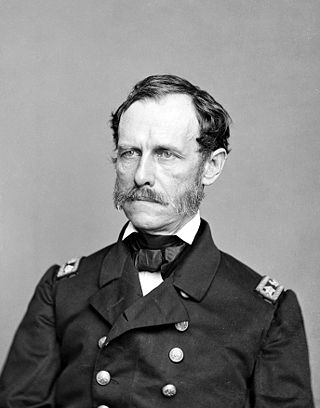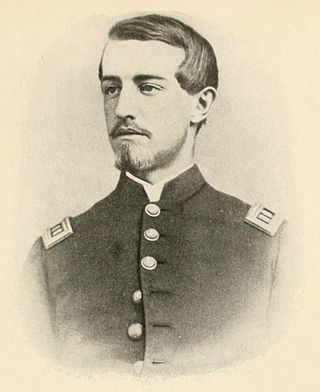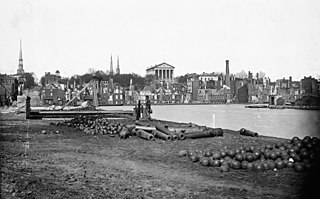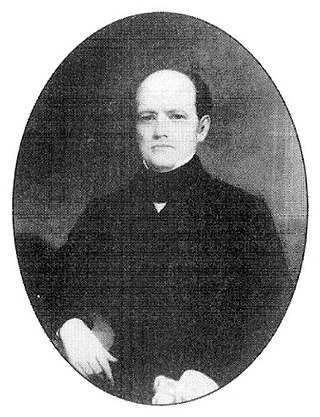
The Richmond–Petersburg campaign was a series of battles around Petersburg, Virginia, fought from June 9, 1864, to March 25, 1865, during the American Civil War. Although it is more popularly known as the siege of Petersburg, it was not a classic military siege, in which a city is encircled with fortifications blocking all routes of ingress and egress, nor was it strictly limited to actions against Petersburg. The campaign consisted of nine months of trench warfare in which Union forces commanded by Lt. Gen. Ulysses S. Grant assaulted Petersburg unsuccessfully and then constructed trench lines that eventually extended over 30 miles (48 km) from the eastern outskirts of Richmond, Virginia, to around the eastern and southern outskirts of Petersburg. Petersburg was crucial to the supply of Confederate Gen. Robert E. Lee's army and the Confederate capital of Richmond. Numerous raids were conducted and battles fought in attempts to cut off the Richmond and Petersburg Railroad. Many of these battles caused the lengthening of the trench lines.

Goochland County is a county located in the Piedmont of the Commonwealth of Virginia. Its southern border is formed by the James River. As of the 2020 census, the population was 24,727. Its county seat is Goochland.

John Adolphus Bernard Dahlgren was a United States Navy officer who founded his service's Ordnance Department and launched significant advances in gunnery.

Dahlgren is an unincorporated community and census-designated place (CDP) in King George County, Virginia, United States. The population was 2,946 at the time of the 2020 census, up from 2,653 at the 2010 census, and up from 997 in 2000.

The Battle of New Market was fought on May 15, 1864, in Virginia during the Valley Campaigns of 1864 in the American Civil War. A makeshift Confederate army of 4,100 men defeated the larger Army of the Shenandoah under Major General Franz Sigel, delaying the capture of Staunton by several weeks.

The Battle of Hampton Roads, also referred to as the Battle of the Monitor and Merrimack or the Battle of Ironclads, was a naval battle during the American Civil War.

Robert EmmettRodes was a Confederate general in the American Civil War, and the first of Robert E. Lee's divisional commanders not trained at West Point. His division led Stonewall Jackson's devastating surprise attack at the Battle of Chancellorsville; Jackson, on his deathbed, recommended that Rodes be promoted to major general. Rodes then served in the corps of Richard S. Ewell at the Battle of Gettysburg and in the Overland Campaign, before that corps was sent to the Shenandoah Valley under Jubal Early, where Rodes was killed at the Third Battle of Winchester.

The Second Battle of Ream's Station was fought during the siege of Petersburg in the American Civil War on August 25, 1864, in Dinwiddie County, Virginia. A Union force under Maj. Gen. Winfield S. Hancock began destroying part of the Petersburg Railroad, which was a vital supply line for Gen. Robert E. Lee's Confederate army in Petersburg, Virginia. Lee sent a force under Lt. Gen. A. P. Hill to challenge Hancock and the Confederates were able to rout the Union troops from their fortifications at Reams Station. However, they lost a key portion of the railroad, causing further logistical difficulties for the remainder of the Richmond-Petersburg Campaign.

Hugh Judson Kilpatrick was an officer in the Union Army during the American Civil War, achieving the rank of brevet major general. He was later the United States Minister to Chile and an unsuccessful candidate for the U.S. House of Representatives.

The Dahlgren affair was an incident during the American Civil War which stemmed from a failed Union raid on the Confederate capital of Richmond, Virginia in March 1864. Brigardier General Hugh Judson Kilpatrick and Colonel Ulric Dahlgren led an attack on Richmond to free Union prisoners from Belle Isle and damage Confederate infrastructure.

Ulric Dahlgren was a colonel in the Union Army during the American Civil War. He was the son of Union Navy Rear Admiral John A. Dahlgren and nephew to Confederate Brigadier General Charles G. Dahlgren.

The Battle of Globe Tavern, also known as the Second Battle of the Weldon Railroad, fought August 18–21, 1864, south of Petersburg, Virginia, was the second attempt of the Union Army to sever the Weldon Railroad during the siege of Petersburg of the American Civil War. A Union force under Maj. Gen. Gouverneur K. Warren destroyed miles of track and withstood strong attacks from Confederate troops under Gen. P.G.T. Beauregard and Lt. Gen. A.P. Hill. It was the first Union victory in the Richmond–Petersburg Campaign. It forced the Confederates to carry their supplies 30 miles (48 km) by wagon to bypass the new Union lines that were extended farther to the south and west.

Richard Lee Turberville Beale was a lawyer, three-term United States Congressman from the Commonwealth of Virginia, and a brigadier general in the Confederate States Army during the American Civil War. He had more than 3-dozen slaves and was a Democrat.

Mississippi was the second southern state to declare its secession from the United States, doing so on January 9, 1861. It joined with six other southern states to form the Confederacy on February 4, 1861. Mississippi's location along the lengthy Mississippi River made it strategically important to both the Union and the Confederacy; dozens of battles were fought in the state as armies repeatedly clashed near key towns and transportation nodes.

Richmond, Virginia served as the capital of the Confederate States of America during the American Civil War from May 8, 1861, hitherto the capital had been Montgomery, Alabama. Notwithstanding its political status, it was a vital source of weapons and supplies for the war effort, as well as the terminus of five railroads, and as such would have been defended by the Confederate States Army at all costs.

State Route 218 is a primary state highway in the U.S. state of Virginia. The state highway runs 30.00 miles (48.28 km) from U.S. Route 1 and US 17 Business in Falmouth east to SR 205 in Tetotum. SR 218 connects suburban communities in Stafford County east of Fredericksburg with rural areas in northern and eastern King George County.

Charles Gustavus Ulrich Dahlgren was a brigadier general of Mississippi State Troops with allegiance to the Confederate States of America during the American Civil War. He commanded the 3rd Brigade of the Mississippi Militia, before a dispute with the President of the Confederate States of America, Jefferson Davis, over transfer of the state troops to the Confederate States Army cost him his career.

The First Battle of Deep Bottom, also known as Darbytown, Strawberry Plains, New Market Road, or Gravel Hill, was fought July 27–29, 1864, at Deep Bottom in Henrico County, Virginia, as part of the Siege of Petersburg of the American Civil War. A Union force under Maj. Gens. Winfield S. Hancock and Philip H. Sheridan was sent on an expedition threatening Richmond, Virginia, and its railroads, intending to attract Confederate troops away from the Petersburg defensive line, in anticipation of the upcoming Battle of the Crater. The Union infantry and cavalry force was unable to break through the Confederate fortifications at Bailey's Creek and Fussell's Mill and was withdrawn, but it achieved its desired effect of momentarily reducing Confederate strength at Petersburg.

Nevada's entry into statehood in the United States on October 31, 1864, in the midst of the American Civil War, was expedited by Union sympathizers in order to ensure the state's participation in the 1864 presidential election in support of President Abraham Lincoln. Thus Nevada became one of only two states admitted to the Union during the war and earned the nickname that appears on the Nevada state flag today: "Battle Born".






















